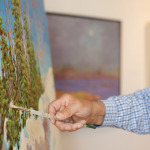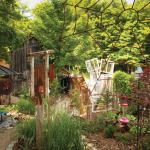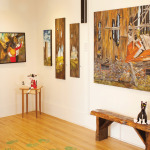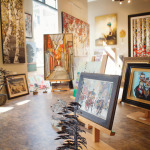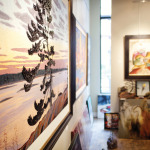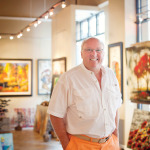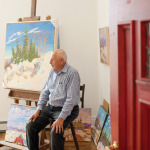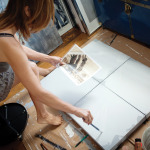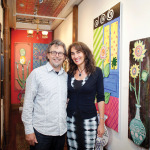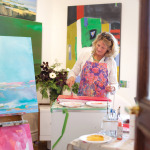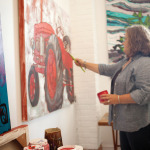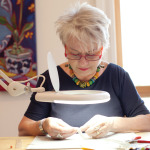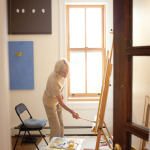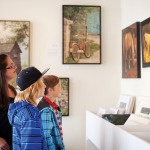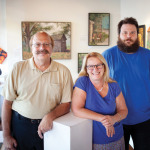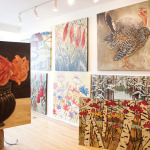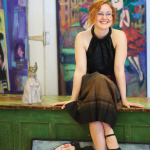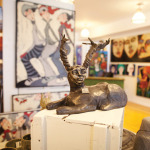Fall is the perfect season to visit our local art galleries, take in a studio tour or art festival, and appreciate the work of our many talented local artists
stories by Emily Worts
photography by Kristie & Brenden Woods
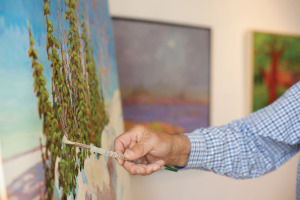
A giant spider web made from recycled rebar is the first thing my four-year-old son Remy notices as we emerge from Flesherton’s ArtsOnTen art gallery out into the adjacent CuckooValleyGarden. My eyes follow Remy’s up above the garden to the suspended, rusty web measuring eight feet across by eight feet tall. My seven-year-old son Miles points to a bicycle, painted green, perched precariously on a wacky crooked wall of uneven timbers and old windows. Snaking down the wall is an old hose, funnelling water into an antique washing basin, painted in eclectic colours.
The soft tumbling sound of water mixes with the music playing from speakers perched in treetops (along with painted chairs, metal woodpeckers and cascades of antique farm implements). My boys are encouraged to pick up one of the many rubber mallets placed around the garden. Before I can stop them, Remy is gonging on a cymbal and Miles is playing a set of giant chimes that sound like cow bells from another time and place. But the idea is not to stop them; in the CuckooValleyGarden the idea is to let them interact, with the goal of making the gallery experience a little less intimidating and a little more fun for future generations of art lovers. “Intimidation is a problem,” says artist Jennifer Stenberg, one of three owners of the ArtsOnTen gallery. “We try to make the gallery as friendly as possible. The garden helps. It warms people up.”
To get to the garden we follow handprints, painted on the ground, that take us around the gallery, up and down stairs, into small rooms that have become secret little galleries of their own, and finally out into the magical space that is the CuckooValleyGarden.
There is a lot of humour in the garden and in the gallery. Papier maché belly dancing cows, seagulls in rubber boots and pigs in tiaras welcome visitors from the front window. “There are no security guards here,” says Stenberg, who admits that on a recent trip to the National Gallery in Ottawa, even she, a gallery owner, felt intimidated by so many uniformed guards staring back at her.
A lack of understanding of art can also lead to intimidation, adds Stenberg. “A whole generation, my generation (she is in her 50s) missed out on art training. In the city there were better art programs, but with so many cuts, art was not treated with importance. Art is something everyone should be able to enjoy.”
In addition to the garden and some light-hearted art, the owners of ArtsOnTen are continually brainstorming ways to bring people into their gallery.
With children’s programs, like paint your own placemats, not only do children look at art every time they eat, but parents are encouraged to peruse the gallery before and after pick up.
“Some parents will shyly admit they have never been in a gallery before,” marvels Stenberg. She wants visitors to know there is absolutely no pressure to buy, but please, she urges, look. “The worst insult to an artist is if you don’t even look at the art.”
All of our local galleries offer a great place to begin an appreciation of ‘live’ art, even if you don’t intend to break out the cheque book. Galleries are open to the public, they’re free, and they are welcoming.
Peter Bright, owner of Brights Gallery, located in Blue Mountain Village, doesn’t believe in jumping on visitors as soon as they walk through the door. His desk is tucked around the corner from the entrance and he always remains seated in his chair, listening to people talking. When he feels the time is right he will step out and ask, “Can I help you with anything? Or are you just cruising?” Bright’s career as a gallery owner started with a simple conversation opener like this and ended up with the purchase of an existing well-respected art gallery nine years ago.
He was in Montreal for the jazz festival, popped into a gallery, bought a painting and, even more significantly, ended up speaking with the gallery owner for hours about running an art gallery. Bright had retired from the corporate world and this conversation inspired him to go home to Burlington and buy a gallery.
“It is dramatically opposed to the corporate world,” he says. “You can’t sell art; art has to sell itself. It hit me like a bug in a windshield.”
Bright knows that not every visitor is going to be a future gallery owner, but he is eager to share his experience and passion. Getting people out of their homes and away from their computers to view art ‘live’ is what it is all about, he says.
“Work on websites hasn’t been professionally photographed. It shows colour differently and it will never look like it does live,” explains Bright. “Paintings reflect light, and you will never get that crispness or that feeling viewing art online. Then there’s the tactile side. Is it a painting that uses a lot of paint? Does it use contours or is it high realism?”
Brights Gallery has become part of the Blue Mountain Village experience. It is open every day of the year and it represents a cross-section of Canadian art.
“People coming to the Village for dinner often pop in,” notes Bright. “It’s a very well-known destination for a little visit.”
Traditionally, art galleries offered a place to go and meet up with friends, exchange ideas and build community. Recreating that sense of galleries as artistic and community hubs has been the vision of Anke Lex and her partner Richard Lex as they continue to build what is quickly becoming known as the cultural centre of Collingwood. “It’s not just art, its community,” says Anke.
In the Tremont Studios there are 11 working artists, all running individual businesses with the unique concept that the artists represent themselves under the umbrella of the Tremont. On the first floor of the same building is the Tremont Hall Gallery, where the Lexes organize exhibits featuring local artists on a two-month rotation. The hall is very casual, and it’s free of charge and self-guiding.
“Lots of people come out and they are really connecting with their community,” says Anke. “It’s why people buy local art, because they need the connection to the artist and the community. We have a lot of visitors coming through, and the artists know they have to sell their work but people aren’t getting the hard sell. It’s about establishing the relationships.”
At 65 Simcoe Street, in a former section of the newspaper building, is a studio gallery called Studio 65. The hallway here is called the Press Gallery, and like the Tremont, hosts exhibits featuring local artists as well as historical exhibits (in partnership with the Collingwood Museum and the local Architectural Conservancy) as well as small productions. Just up the street are the Creemore Coffee Studio and the Collingwood Community Food Co-op. “These are all meeting places where people make you feel welcome,” says Anke. “Because of all the art around, people are talking about art and there is so much momentum.”
One of the Lexes’ passions is getting children involved in the arts. “If you get kids interested in art, you are nurturing art as part of the community, as a natural part of life,” says Anke.
The Lexes host shows just for kids, put on a hugely successful summer street festival, the Day of Delight, with music, dancing, puppeteers and a parade, and participate in the Magic of Children and the Arts.
At most galleries, children are encouraged to visit, but there is a protocol: “Don’t touch but always ask questions,” explains Anke. “We have to nurture upcoming generations of art lovers.”
High school students often visit the Tremont, with or without their art teachers, because of the high quality of shows the Tremont puts on. The gallery becomes a teaching tool, that is both educational and inspirational.
The Blue Mountain Foundation of the Arts (BMFA) encourages high school students to become involved in the arts through awards given out to four area high schools and the opportunity to enter juried art shows. Other awards, including the Robert G. Kemp Trust Award and the Murray Jacob Clerkson Award, are open to the general public.
“We are always encouraging participation in the arts,” says Susan Cook, BMFA administrator. “We don’t want it to be seen as just high-brow because it (art) does take so many different forms. Art is not one thing.” In the BMFA Gallery on Collingwood’s main street, there is something for everyone.
“You may not like looking at paintings, but there is also sculpture, textile, pottery, jewelry. This is all part of our local arts and culture scene. It is a place to enjoy something that is unique and one of a kind, not mass produced,” notes Cook.
“It opens the mind and makes people feel that things like this are possible. We are here showcasing and promoting the local art scene.”
The BMFA is a volunteer-run organization with over 350 members. The gallery hosts monthly shows with opening receptions, and from time to time artists give talks, demonstrations and workshops.
Cook and the BMFA believe that arts and culture are integral to a well-rounded community. “Collingwood is more than just recreation,” she says. “People who are moving here are looking for that intellectual component, something intelligent to be involved in. It is an outlet for people with more time. There are a lot of active retirees joining the organization.”
Cook and the BMFA would like to see an official designation of Collingwood as a cultural destination. “The more art-related businesses and organizations located in the downtown core, the more we can advocate that we are a cultural destination,” says Cook. “An official designation would help with tourism and the economy.”
‘Artsburg’ may not be an official designation for Clarksburg, but unofficially it has become the recognized moniker for this tiny, gallery-dense town adjacent to Thornbury. The term was coined by late artist Bill Hartman as a joke, but it stuck.
“When we came up to Clarksburg, it was a bunch of empty stores,” recalls Phil McCormack, co-owner of Loft Gallery in Clarksburg. That was June 2006 and there were no arts businesses on the strip, he says.
“We were really isolated and we had to spend a lot of money advertising because no one knew where Clarksburg was.”
Today there are several galleries, photo studios, metal workers and antique shops in the small village. There is even an Artsburg day in July, a street festival that attracts hundreds of people.
McCormack admits many of the people who stop in to the gallery are on their way to someplace else. He hands out maps to people who are lost and offers water and a washroom to weary bikers and hikers.
“Ninety percent of people who come in, come in to look. They come in with their dogs, in their ski gear, with their bike equipment,” he laughs. “We act like the public gallery up here. People are looking and they are looking for fun, and that’s okay. We are trying to make them comfortable. We get known that way.”
From gallery to gallery, it’s all about first impressions and making people feel welcome. Whether it’s a large picture window with a huge rendition of a spectacular and familiar landscape or simply an open door, which you will find more often than not at the Marsh Street Gallery in Clarksburg, it’s all about getting people in. “With the open door, people are more prone to come in; its more welcoming,” says Beverley Reed, one of the artists at the Marsh Street Gallery, a local art co-op featuring 14 artists under one roof. “If the door is open, come in.”
An open door means someone is there, usually painting, or making jewelry.
“We all paint in there and we take turns running the gallery,” says Reed. “We like to think of it as a working gallery. It’s a great selling point. People become interested and engaged.”
Artists welcome people looking over their shoulders, studying their technique, asking questions. It helps to build the relationship.
Rick and Lyne Burek bought the Mad & Noisy gallery in Creemore almost two years ago, and for them it’s all about relationships and family. If they can’t be at the gallery, their son is. If their son can’t be at the gallery, one of the showing artists watches the space for them. “We’re keeping it close to the family, but our family also includes the artists,” says Rick.
Locals have also become part of the gallery fabric. “We have locals who come in regularly to view the art and they like the atmosphere of the gallery. It’s spacious, clean and it’s very comfortable. Out front there are the Muskoka chairs; people like to gather there.” Market days are some of the busiest, and the gallery is one of the stops locals make between picking up their fresh produce and preserves and grabbing their weekend paper and a coffee.
Locals also become part of the art scene each year with the CreemoreCentric group show, hosted by the gallery. This square foot art show encourages everyone to try their hand at being an artist. People purchase 12 x 12 canvases from the gallery and have a couple of months to work on their piece before making the big reveal on opening night. A silent auction wraps it all up on the final night with enthusiastic bidding for one-of-a kind artwork.
“We try to promote local talent,” says Burek. “We had one person who worked at the local Home Hardware and he is into photography. He photographed horses pulling a trailer of barrels; it was an amazing shot. I am amazed by how much talent there is.” The Mad & Noisy Gallery has something for everyone, says Burek, and that’s why people like to come in.
“We have pieces people can identify with. We can see how people feel after they leave the gallery; they are very content. Anyone can feel something from a piece of art.”
S
ue Tupy of Curio in Clarksburg agrees. “People see original art versus the Winners piece hanging in their home and they recognize the positive energy of an original piece of art,” says Tupy, adding it is this feeling of connecting with positive energy that people take with them when they leave the gallery.
“There may not be the expectation of leaving with a painting, but they leave excited by the process.”
Looking at art, especially in Clarksburg with all its galleries, can become exhausting and completely overwhelming, says Tupy, who admits that when she is visiting a gallery she doesn’t want to be touched, looked at or bothered in any way. She can tell by a person’s “hello” if they feel the same way. But with a little guidance the experience can be a very enjoyable one, she says.
“People may want to be engaged but they may not know how,” says Tupy of Curio’s visitors. “That is my job, to initiate it. Their body language tells us what they know or don’t know. The bottom line is it’s our job as gallery owners to bring that out of them.”
As a salesperson it’s also Tupy’s job to help her customers find a piece of art that works for them. As an artist it is Tupy’s job to believe in the art she sells.
“It’s about honouring their decision, having sincerity and making the experience as genuine as possible. It’s about having confidence that what they’ve bought is the right choice,” says Tupy. “A happy customer is your next customer.”
Local galleries are almost always open on weekends, and some are open up to seven days a week. Opening receptions are happening all the time, in galleries, bookstores, libraries, cheese shops, coffee shops … even in hair salons. These events are fun, social and free. It is an opportunity not only to dress up and enjoy a free glass of wine but to meet and speak with the artist about what they do and how they do it, to meet other like-minded people and to be inspired.
Be brave when entering a gallery and check your intimidation at the door. Everyone has to begin their art education somewhere, and everyone has their own response to art, so there is no right or wrong. Don’t be afraid to look and don’t be afraid to ask; that’s what our galleries are here for. ❧







